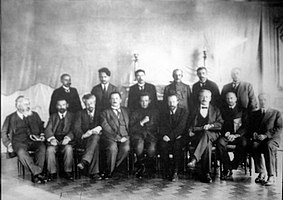Provisional Government of Russia
| Lvov Government | |
|---|---|
|
9th cabinet of Russia |
|
 |
|
| Date formed | 2 March [15 March, N.S.] 1917 |
| Date dissolved | July 1917 |
| People and organisations | |
| Head of government | Georgy Lvov |
| Head of state |
Alexis II (unproclaimed) |
| Member party | Progressive Bloc |
| Status in legislature | Coalition |
| Opposition cabinet | Executive Committee of Petrograd Soviet |
| Opposition party | Socialist coalition |
| Opposition leader | Nikolay Chkheidze |
| History | |
| Incoming formation | Golitsyn |
| Outgoing formation | Kerensky I |
| Predecessor | Nikolay Golitsyn |
| Successor | Alexander Kerensky |
| Kerensky First Government | |
|---|---|
|
10th cabinet of Russia |
|
 |
|
| Date formed | July 1917 (see July Days) |
| Date dissolved | 1 September 1917 |
| People and organisations | |
| Head of government | Alexander Kerensky |
| Head of state |
Grand Duke Michael (conditionally) Alexander Kerensky (de facto) |
| Member party | Socialist-Revolutionaries |
| Status in legislature | Coalition |
| Opposition cabinet | Executive Committee of Petrograd Soviet |
| Opposition party | RSDLP |
| Opposition leader | Nikolay Chkheidze / Leon Trotsky |
| History | |
| Incoming formation | Lvov |
| Outgoing formation | Kerensky II |
| Predecessor | Georgy Lvov |
| Successor | Alexander Kerensky |
Coordinates: 59°56′27″N 30°18′47″E / 59.9408°N 30.313°E
The Russian Provisional Government (Russian: Временное правительство России, tr. Vremennoye pravitel'stvo Rossii) was a provisional government of the Russian Republic established immediately following the abdication of Tsar Nicholas II of the Russian Empire on 2 March [15 March, New Style] 1917. The intention of the provisional government was the organization of elections to the Russian Constituent Assembly and its convention. The provisional government lasted approximately eight months, and ceased to exist when the Bolsheviks gained power after the October Revolution in October [November, N.S.] 1917. According to Harold Whitmore Williams the history of eight months during which Russia was ruled by the Provisional Government was the history of the steady and systematic disorganisation of the army.
The Provisional Government was formed in Petrograd by the Provisional Committee of the State Duma and was led first by Prince Georgy Lvov and then by Alexander Kerensky. It replaced the institution of the Council of Ministers of Russia, members of which after the February Revolution presided in the Chief Office of Admiralty. At the same time the Russian Emperor Nicholas II abdicated in favor of the Grand Duke Michael who agreed that he would accept after the decision of Russian Constituent Assembly. The Provisional Government was unable to make decisive policy decisions due to political factionalism and a breakdown of state structures. This weakness left the government open to strong challenges from both the right and the left. The Provisional Government's chief adversary on the left was the Petrograd Soviet, which tentatively cooperated with the government at first, but then gradually gained control of the army, factories, and railways. The period of competition for authority ended in late October 1917, when Bolsheviks routed the ministers of the Provisional Government in the events known as the October Revolution, and placed power in the hands of the soviets, or "workers' councils," which had given their support to the Bolsheviks. The weakness of the Provisional Government is perhaps best reflected in the derisive nickname given to Kerensky: "persuader-in-chief."
...
Wikipedia
